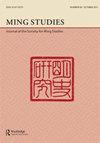Ming News
IF 0.3
0 ASIAN STUDIES
引用次数: 0
Abstract
“Many of the powerful emperors of China’s last dynasties— the Ming (1368–1644) and Qing (1644–1912) — were patrons, collectors, and casual practitioners of the arts. They used art to legitimize and glorify their rule. It served many functions: for state rituals, for expressing piety, to dazzle palace visitors, to build diplomatic relations, and for personal pleasure. The emperors’ officials oversaw the palace painting academy, imperial porcelain factory, and numerous other workshops. Their artists creatively reworked earlier traditions, which bolstered the emperors’ legitimacy by showing their command of China’s long history. Many emperors supported international trade with Japan and Korea, Southeast Asia, the Himalayas, and the Indian subcontinent as well as the Islamic world and Europe. These exchanges helped shape the development of Chinese art, especially in the early fifteenth-century and eighteenth-century courts emphasized in this gallery. While the Ming and Qing courts followed many of the same practices in government and art, the Ming emperors were native Chinese, and the Qing rulers were not. Heirs of Manchu chieftains who swept into China on horseback from the north, the Qing emperors embraced all things Chinese, but also steadfastly maintained their own traditions.” From the exhibition description, https://www.freersackler.si.edu/exhibition/ looking-out-looking-in/明报
“中国最后一个朝代的许多强大的皇帝——明(1368-1644)和清(1644-1912)——是赞助人、收藏家和艺术的临时实践者。他们用艺术来合法化和美化他们的统治。它有很多功能:国家仪式,表达虔诚,让宫殿游客眼花缭乱,建立外交关系,以及个人娱乐。皇帝的官员监督着宫廷画院、皇家瓷器厂和许多其他作坊。他们的艺术家创造性地改写了早期的传统,通过展示他们对中国悠久历史的掌控来增强皇帝的合法性。许多皇帝支持与日本和韩国、东南亚、喜马拉雅山、印度次大陆以及伊斯兰世界和欧洲的国际贸易。这些交流帮助塑造了中国艺术的发展,尤其是在15世纪初和18世纪的宫廷中。虽然明朝和清朝在政府和艺术上都遵循着许多相同的做法,但明朝的皇帝都是土生土长的中国人,而清朝的统治者则不是。从北方骑马进入中国的满族首领的继承人,清朝皇帝拥抱中国的一切,但也坚定地保持着自己的传统。”从展览描述来看,https://www.freersackler.si.edu/exhibition/向外看向内看/
本文章由计算机程序翻译,如有差异,请以英文原文为准。
求助全文
约1分钟内获得全文
求助全文

 求助内容:
求助内容: 应助结果提醒方式:
应助结果提醒方式:


